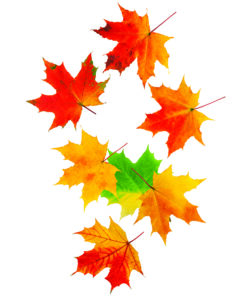As fall foliage colors take over the landscape, shifting from deep greens to cozy browns and reds, it’s only a matter of time before those leaves are hitting the ground.
When that happens, conscientious gardeners and homeowners have to decide to either let the leaves lie or haul them away.
Lou Meyer, ISA certified arborist at Davey Tree advocates for not removing the leaves, but only in certain situations.
“We like to leave the leaves whenever possible,” Meyer said, but if the leaves cover turf areas or landscaped beds for any length of time, it could lead to bad news.
Heavy coverage blocks the sunlight from hitting the grass or plants which interrupts their photosynthetic capabilities.
“Their food source is gone, you’re basically starving them,” Meyer said. 
Even if it’s just in certain places, dense matted leaves can also harbor fungus that can infect the plants you want to keep looking good. Continued over time, it can also shift the soil pH which further impair plant growth and require soil amendments to bring back in line.
So, if it’s just a few trees in the yard, an option Meyer likes is mowing the leaves and letting the shredded matter settle into the turf area and become a food source for it. It won’t block out the sun and it’ll break down faster.
If your yard is loaded with large trees, just mowing won’t be enough. Meyer recommends removing at least enough of the leaf material to where mowing what’s left will be a help and not a hinderance to your turf areas and landscaping.
Just because you remove it, doesn’t mean you lose it, however.
You or your landscaper can stockpile and use it for mulch the following year or add it to a compost bin as a much-needed carbon source in that process and then incorporate the compost in your soil. It’s a longer and more labor-intensive process, but brings a nice reward in happy healthy plants.
Meyer offered one caveat: Oak leaves take much longer to decompose than leaves of many other common trees, so it’s important to know what species you have and if trying to keep separate piles is worthwhile.
Some municipalities will take raked piles of leaves away and make it into their own saleable mulch, he added.
If your space has a more natural look where the leaves would lie, Meyer said letting the leaves fall where they may is a perfectly fine option. It is after all how it would happen in a forest setting.
“It has tremendous benefit for wildlife,” Meyer said, which includes native pollinators. “That’s where they house themselves in the winter and have babies in the springtime.”
Leaves turning color makes for a great scenic view, but it’s also a good idea to watch your trees throughout the year. If something looks off, such as discolored or misshapen leaves throughout the tree, it’s probably time to call an arborist, local Extension horticulturalist or dig into the research yourself.
“If you have an ailing tree, it’s a good idea to get those leaves off site,” Meyer said.
Properly diagnosed, you’ll help your tree but with some diseases, you’ll keep the disease from spreading through the leaves’ movement.
Dogwood anthracnose is one example, Meyer cited.
The disease stays in the leaves producing spores which can overwinter and become airborne in the spring and fall and blow around onto susceptible plants.
Browning leaves in the summer and earlier-than-normal defoliation are signs to watch out for.
Meyer added if you can’t identify the problem or have other questions, calling an arborist is recommended and most offer free consultations.
“Just have an arborist come out. We love to talk trees,” he said.



